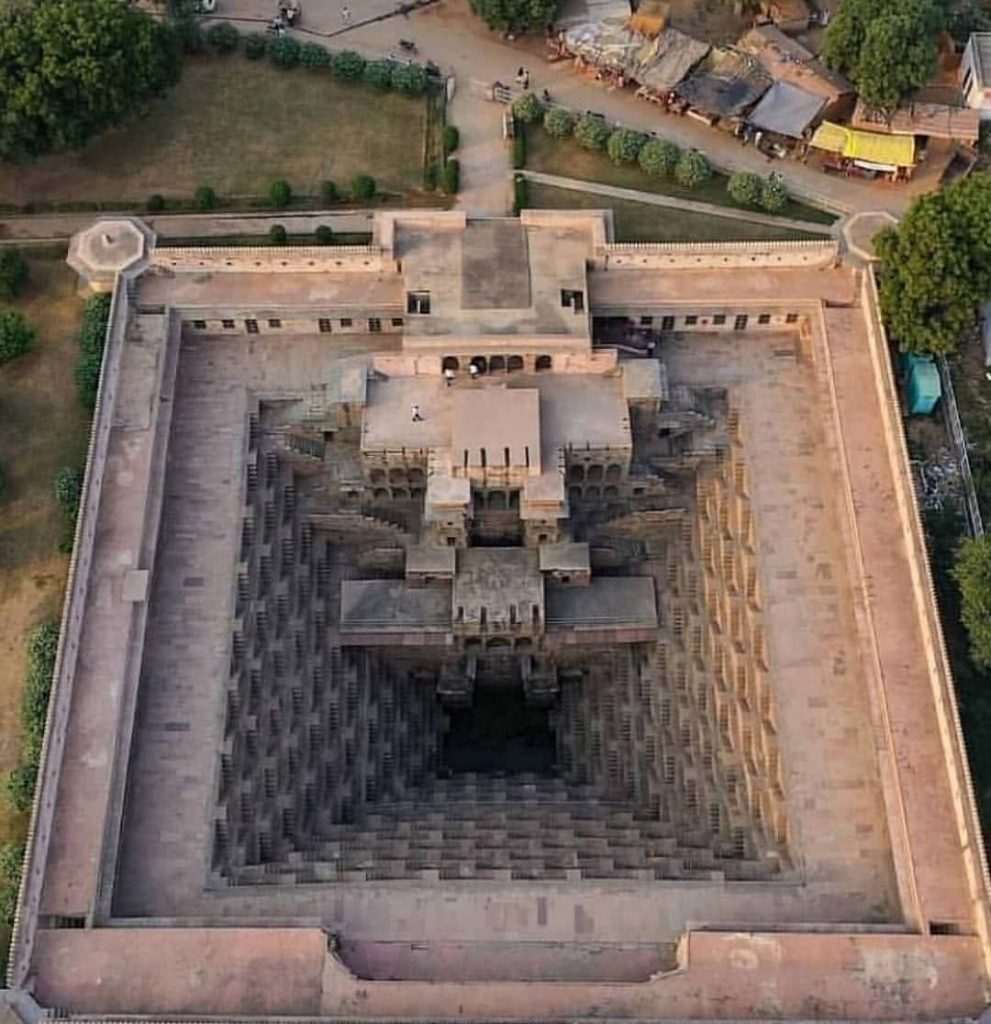Reinventing a new purpose for the forgotten stepwells of India (well what else!)
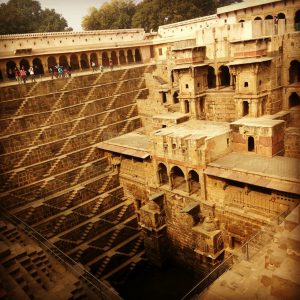 Step wells are subterranean buildings that were constructed for the purpose of collecting and storing water. Such wells with marvelous architecture and engineering skills are found in the arid states of northern India majorly in the states of Gujrat and Rajasthan. An efficient water management system was the key to the advancement of any ancient civilization, be it Indus Valley (great bath) or Ancient Romans(aqueducts). The steps enabled access to water all around the year though the water level keeps fluctuating.
Step wells are subterranean buildings that were constructed for the purpose of collecting and storing water. Such wells with marvelous architecture and engineering skills are found in the arid states of northern India majorly in the states of Gujrat and Rajasthan. An efficient water management system was the key to the advancement of any ancient civilization, be it Indus Valley (great bath) or Ancient Romans(aqueducts). The steps enabled access to water all around the year though the water level keeps fluctuating.
These were primarily built for providing water, however many of them served as active social hubs. Some of these step wells were elaborate and associated with temples while some of them has living quarters underneath. They provided for a cooler living quarters during the harsh summer months. The inverted funnel shape of the structure could be the reason for its stability and strength.
Reinventing newer possibilities for these marvellous structures could be challenging yet exciting. While restabilising the original use for which the structure was constructed there are multiple opportunities hidden behind the architecture of these wells, that can be adapted to the modern day requirements.
- Chand Baori, Abhaneri, Rajasthan
Built-over a thousand years ago, the step-well of “chand baori” in Rajasthan is one of the largest and deepest stepwells in the world and also one of the most beautiful ones. Composed in a perfect square geometry with steps on three sides and living quarters penetrating into the earth on the fourth side, creates a magical maze and precise geometric pattern which evokes interest and curiosity in the viewers.
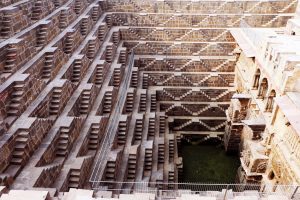
The presence of water body below cools down the cellar rooms and creates a micro climate within during the hot and dry summer months. The square geometric pattern is repeated into 3500 steps which goes deep down into the water-tank. The steps are designed to create a pattern that evokes a play of light and shadow at every point of time during the day. The pavilion / living quarters on one side is beautifully decorated with Jharokhas and arches, to give a spectacular view. There are platforms or balcony’s created at intermediate levels inside the well, that can be accessed from the internal rooms. The inverted pyramidal shape of the structure could be the reason for its strength and stability.
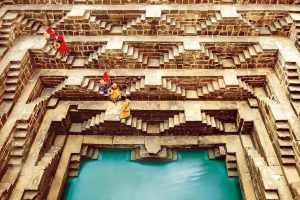 Can this marvelous structure of Chand baori be reused and adapted into any modern use rather than keeping it as an unattended heritage monument, least maintained for the fewer tourists?
Can this marvelous structure of Chand baori be reused and adapted into any modern use rather than keeping it as an unattended heritage monument, least maintained for the fewer tourists?
Since last few years the location have been in the hot-list for movie directors from across the globe. Careful architectural interventions can bring out the beauty of the structure and turn them into usable spaces.
Here are few recommendations for revitalizing the structure to its full potential.
- Destination Wedding Venue in an inverted pyramid
 With the change in trends, weddings are turning out to be an extravagant affair with family and fewer close friends. They are meant to be functions where everyone can spend quality time together to celebrate the event and make it memorable. The place has the potential to be turned into stunning destination wedding spots which are away from the hustle and bustle of the city. The Indian heritage is no less of architecture value than any European Castles or Forts. Careful architectural and engineering service interventions can bring out the beauty of the structure and turn them into romantic & dramatic cultural destinations to hold weddings and corporate events.
With the change in trends, weddings are turning out to be an extravagant affair with family and fewer close friends. They are meant to be functions where everyone can spend quality time together to celebrate the event and make it memorable. The place has the potential to be turned into stunning destination wedding spots which are away from the hustle and bustle of the city. The Indian heritage is no less of architecture value than any European Castles or Forts. Careful architectural and engineering service interventions can bring out the beauty of the structure and turn them into romantic & dramatic cultural destinations to hold weddings and corporate events.
- Performance theatres
 Performance theatres are part of every culture. the inverted funnel shape gives it the opportunity to become a stage/arena with existing seating facilities. Providing a stage or arena in the water can give a spectacular view with a reflection of the water body. These can be venues for performances by artists of national and international fame.
Performance theatres are part of every culture. the inverted funnel shape gives it the opportunity to become a stage/arena with existing seating facilities. Providing a stage or arena in the water can give a spectacular view with a reflection of the water body. These can be venues for performances by artists of national and international fame.
- Meditation or Wellness Centers
 The calmness of the place evokes peace and helps one to reflect self, and connect with the past. Spiritual centers, yoga centers, Ayurveda centers can use the potentials of the site and turn them into crowd pullers both from India and abroad.
The calmness of the place evokes peace and helps one to reflect self, and connect with the past. Spiritual centers, yoga centers, Ayurveda centers can use the potentials of the site and turn them into crowd pullers both from India and abroad.
- Research Institutes and Colleges
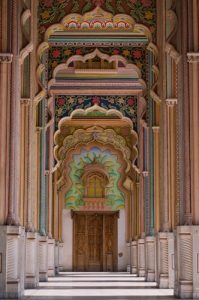 There is a lot to learn from the ancient engineering of water management skills. The site can be turned out into learning centres and research centres, history colleges. Such magnificent structures themselves has the potentials to instigate younger minds to innovation and creativity.
There is a lot to learn from the ancient engineering of water management skills. The site can be turned out into learning centres and research centres, history colleges. Such magnificent structures themselves has the potentials to instigate younger minds to innovation and creativity.
Have a look at the Chand Baori: (https://www.archdaily.com/878527/the-astonishing-vanishing-stepwells-of-india)
Have a look at the Step Wells of India: https://www.archdaily.com/395363/india-s-forgotten-stepwells

